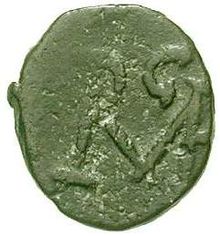Libius Severus
A native of Lucania,[10][5] Severus was the fourth of the so-called "Shadow Emperors"[11][2][12][13] who followed the deposition of the Valentinianic dynasty in 455.
[14]: 435 [2]: 227 In Gaul and Dalmatia officials loyal to Majorian refused to submit to Severus' rule, and Northern Italy was invaded by the Alans.
Modern scholars are divided as to the authority of this attribution: some (including the PLRE) say the text is corrupt and its meaning uncertain,[1][19] while others argue it was a signum or supernomen deriving from the word for serpent.
The West on the other hand underwent a series of invasions, major political upheavals, and losses of important provinces.
By the early 460s, Britain had been abandoned, Africa had been conquered by the Vandals, and Hispania was occupied by the Suebi and the Visigoths (who were foederati of the empire).
Valentinian was deposed, his surviving family was taken captive by Gaiseric, and the replacement emperor (Maximus) was killed while Rome was sacked.
Ricimer was a popular and successful military commander, but because he was of non-Roman origin, he was not an acceptable candidate for emperor in the minds of the Senate and people of Rome.
Recognized by the eastern emperor Leo I, Majorian's reign saw political reform and the strengthening of Roman control over Gaul and Hispania.
[2]: 215 [11]: 97 [16]: 237 He seems to have spent most of his rule in Rome rather than Ravenna, but whether this was out of personal preference, political expediency, precedent set by Valentinian, or Ricimer's prerogative is unknown.
During this interregnum, a political struggle for the succession ensued between Ricimer, eastern emperor Leo I, and Gaiseric, the King of the Vandals.
Immediately after the death of Majorian, the western court faced three political obstacles: These problems would persist for the entirety of Severus' reign.
Though Ricimer would eventually subdue both Aegidius and Marcellinus, the separation of Dalmacia from the western empire would prove permanent.
Agrippinus asked for support from the Visigoths, and with their help moved against Aegidius and his Frankish allies, led by King Childeric I.
[13] However, in exchange for their support, in 462 the Visigoths received the city of Narbonne, thus gaining access to the Mediterranean Sea and separating Aegidius from the rest of the empire.
Priscus reports that at some point during Severus' reign, some representatives of the Italian aristocracy went to the Emperor to plead for a reconciliation with Gaiseric.
This view is expressed by Edward Gibbon, who wrote "during that period [the six years between Majorian and Anthemius], the government was in the hands of Ricimer alone.
[32] Other physical evidence includes a rectangular bronze plaque (perhaps an exagium, an official standard weight for coins) reading, "Health to our Lords [Leo and Severus] / and the patrician / Ricimer.
[13][nb 5] However, Marcellinus' use of the term has been interpreted a number of ways, including as a reflection of his royal Gothic heritage, his increased political power and autonomy, or early evidence for his monarchical ambitions.


